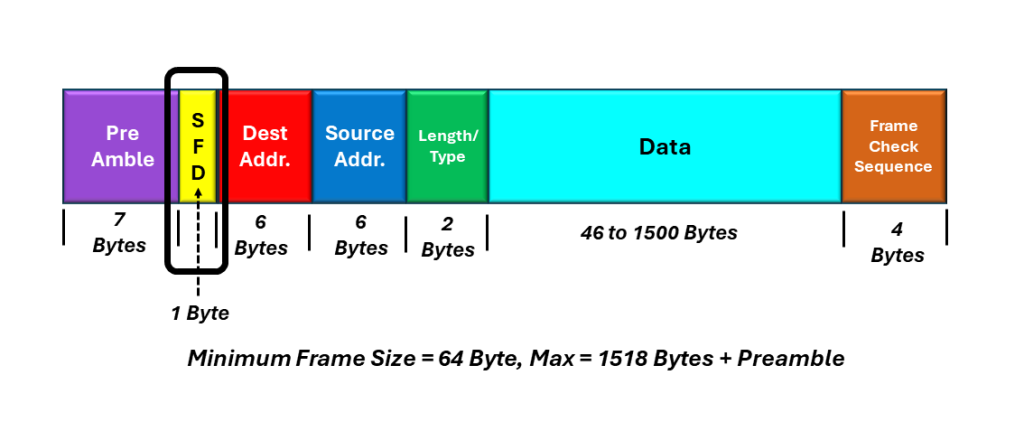The Preamble is the first 64 bytes within each Ethernet frame.
In Figure 1, I show an illustration of the Ethernet frame, with the Preamble Highlighted.

Figure 1, Illustration of the Ethernet frame with the Preamble Highlighted.
The original purpose of the Preamble was to provide an Ethernet Receiver or Station (which is just starting to receive an Ethernet frame) a sequence of bits to allow for it to synchronize itself with this incoming data before it receives the actual important data within the frame.
Some Background
In early 10Mbps Ethernet, stations would only receive data from other stations when one station sent a frame to the other stations.
When there was no data to send, the stations transmitted nothing, and the line was mostly quiet.
In Figure 2, I illustrate two Ethernet stations connected, transmitting no data to each other.

Figure 2, Illustration of two Ethernet stations, connected, transmitting no data to each other.
In this “quiet condition,” the line (or the Ethernet connection) between the two stations is quiet, and there are almost no electrical signals or activity on the line.
Then, when a station starts to send an Ethernet frame to another station, it would first send a preamble to “wake up” the receiving station and allow that station to synchronize itself with this incoming data stream (that is, the Ethernet frame).
A More Technical Discussion
Stated more technically, each Ethernet station (that is capable of receiving an Ethernet frame) has some sort of “Clock-Recovery” PLL (or Phase-Locked Loop). The whole purpose of the Preamble (preceding the Ethernet frame) was to allow the receiving circuitry (with the PLL) to receive this sequence of bits (or transitions within the data) and obtain synchronization with this incoming data stream (or Ethernet frame) before the important data starts to arrive (e.g., the Destination Address).
What is this Preamble?
The Preamble is mostly a repeating sequence, with a repeating “1010…” pattern. The length of this preamble is 64 bits (or 8 bytes).
Again, the purpose of this Preamble (back in the old days) was to place a sequence of electrical (or optical) transitions (e.g., repeating 1010… data) within an Ethernet line and (effectively wake up the Ethernet receiver) before the receiving station actually receives useful and meaningful information (that it needs to receive and interpret properly).
In Figure 3, I show a close-up illustration of the Preamble within an Ethernet frame.

Figure 3, Illustration of the Preamble within an Ethernet frame.
Figure 3 shows that the Preamble consists of 7 bytes of the value: 0xAA or 10101010 in binary format. However, the last byte within the Preamble is of value 0xAB (or 10101011 in binary format).
Hence, the Preamble is mostly a repeating 1010.. pattern, lasting for 64 bits (or 8 bytes).
However, depending upon which Ethernet standard you are using, that last byte (within the Preamble) is defined differently.
The DIX Frame (or Standard)
The DIX Standard defines this entire 8-byte sequence (or 0xAA, 0xAA, 0xAA, 0xAA, 0xAA, 0xAA, 0xAA, 0xAB) as the Preamble.
I show the definition of the Preamble (per the DIX Standard) in Figure 4.

Figure 4, DIX Definition of the Preamble.
IEEE 802.3 Frame (or Standard)
The IEEE 802.3 standard defines the Preamble as 7 bytes of the repeating 0xAA strings. However, it defines the last byte of the Preamble (the byte with the value 0xAB – as the Start of Frame Delimiter (SFD) byte.
I show the definition of the Preamble (per the IEEE 802.3 standard) below in Figure 5.

Figure 5, IEEE 802.3 Definition of the Preamble
Important Things to Note about the Preamble
Whether operating in the DIX Standard or the IEEE 802.3 standard, the Preamble (or the sequence of data that stations transmit BEFORE each Ethernet frame is the same between the two standards.
Additionally, both standards called for the 8th byte to be of value 0xAB (or 10101011 in binary format). This particular byte (called the Start of Frame Delimiter byte in the IEEE 802.3 standard) warns the receiving Ethernet station that the Preamble is about to end and that the very next byte is part of the Destination Address.
I show the IEEE 802.3 (Basic) Ethernet Frame format in Figure 6 below, which illustrates my last point.

Figure 6, Illustration of the IEEE 802.3 Standard (Basic) Ethernet frame.
Are Preambles Still Used in Ethernet Frames?
In modern Ethernet, we have constructed our high-speed Ethernet data-streams to behave more like CBR (or Constant Bit Rate) signals, rather than bursty streams of traffic (with long idle periods between the reception of Ethernet frames). Hence, the Preamble no longer functions as a warm-up string of data to synchronize the receiver to the incoming Ethernet frame.
However, IEEE has kept the Preamble within the Ethernet standard documents. They chose to do this in order to maintain some backward compatibility between the various flavors/types of Ethernet.
IEEE has largely kept the IEEE 802.3 (Basic) Ethernet frame, exactly the same, over the decades of development within Ethernet technology.

